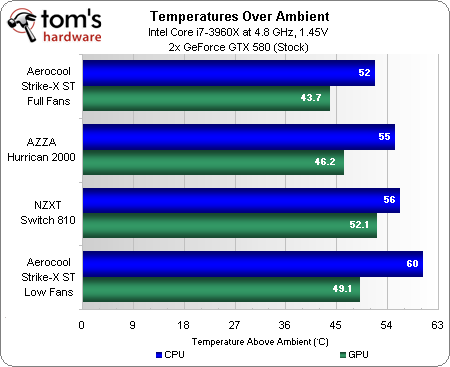Four ATX Cases For High-Capacity Water Cooling, Reviewed
Big radiators need lots of space that most enclosures simply weren't designed to offer. We're using Swiftech’s latest triple-fan cooler to test the fitment and performance in four cases supposedly set up to accommodate high-end water cooling setups.
Temperature, Noise, And Acoustic Efficiency
We tested the thermal properties of each case at maximum CPU and near-maximum GPU loads, using 11 threads of Prime95 and looping 3DMark 11's first test simultaneously. We locked the fans of our graphics cards at maximum speed to gauge the peak cooling performance without any added variability.
A well-placed intake fan and wide open side panel allow Aerocool’s Strike-X ST to lead at its highest fan speed. Azza takes second, place while NZXT follows close behind. Note that the Hurrican 2000’s fan controls are hard-wired to its top panel fans, which were replaced as part of our cooler installation.
We continued to use the fastest GPU fan speed through our full-load noise-level tests, but let those fans spin down completely for our idle tests. Mesh side panels usually fare poorly in this test at full GPU fan speed.
Remembering that low-speed fan mode gave Aerocool’s Strike-X ST a last-place finish in our temperature charts, we weren’t surprised to see a low noise level at idle. The noise under a full load is a completely different matter, as the same unit’s mesh side panel allows nearly 100% of the GPU cooler noise to pass through.
NZXT edges out Azza, and users who want the best of both cooling and noise can even try connecting their fans to thermally-controlled motherboard headers.
A comparison of temperature to noise should be a matter of simple division, except that we want the case with the lowest temperature to have the highest score. To achieve this inverse scale, we first divide the average temperature of all cases/all tests (52° C over ambient) by the average temperature of each individual case. We then divide the average noise level of each case by the average noise level of all cases (43 dB). Finally, we divide temperature (inverse scale) by noise (direct scale).
The resulting relative efficiency chart relates each case’s performance to the average of all tested cases. For example, at 105.4% of average, Aerocool’s full-fan-speed Strike-X ST performs 5.4% better than average.
Get Tom's Hardware's best news and in-depth reviews, straight to your inbox.
Current page: Temperature, Noise, And Acoustic Efficiency
Prev Page Test Settings And Benchmarks Next Page Triple-Fan Water Cooling Cases, Evaluated-
EzioAs Too bad we can't see the full build on the cosmos II. Maybe cooler master should have sent the storm trooper insteadReply -
wolfram23 Should have put the rad in the bottom of the Cosmos II by removing the HDD trays. Seems like it should fit there.Reply
Also, Swiftech makes a sweet kit although I can't imagine the size of the triple rad. Using the Edge 220 myself, love it. Fits in my Antec 900 II. -
wolfram23Should have put the rad in the bottom of the Cosmos II by removing the HDD trays. Seems like it should fit there.Also, Swiftech makes a sweet kit although I can't imagine the size of the triple rad. Using the Edge 220 myself, love it. Fits in my Antec 900 II.The Cosmos II only accepts a 2 X 120 rad in the HDD compartment. Its too bad that toms wasn't able to complete the build in the cosmos II. Maybe within the end of the year, Cooler Master will introduce the Cosmos S II and fix all those enthusiast complains that i read.Reply
-
hellfire24 i would take Switch!it's a personal choice no offence to others they are great too.Reply -
theuniquegamer The Nzxt switch 810 is a good overall case. Too bad they can't fit the rad to cosmos ii . May be they should try the svgtech h80 triple rad air cooler .Reply -
theuniquegamer The Nzxt switch 810 is a good overall case. Too bad they can't fit the rad to cosmos ii . May be they should try the svgtech h80 triple rad air cooler .Reply -
Crashman theuniquegamerThe Nzxt switch 810 is a good overall case. Too bad they can't fit the rad to cosmos ii . May be they should try the svgtech h80 triple rad air cooler .Guys, I'm collecting suggestions for future uses of the left-over Cosmos II.Reply
1.) Yes it supports STANDARD 3-fan radiators. It just couldn't be compared to other cases if it had a different cooling system.
2.) It can probably also be MODIFIED to fit the radiator used in the article.
So, do you have a custom system suggestion? or are you looking for a modification article? Like I said, I'm taking suggestions. Thanks! -
EzioAs For the Cosmos II, try doing a full build with a standard 360 rad in the top and a 240 rad in the bottom compartment with a 3960X cpu and 2 LCS 7970 from powercolor to show the lowest temps and highest overclock on custom watercooling build. Maybe do an extreme build guide or something like that with the cosmos II. Just a suggestionReply -
acekombatkiwi1 If you want to stick with Swiftech gear use the 240 edge kit down the bottom with a Swiftech 360 QP up top.Reply -
koogco It seems a bit silly to use a rad with bits tagged on the end, since most good cases would be designed without those bits in mind. I can see the apeal of using something that is almost like closed loop, but using one of the optical-bay resevoirs with built in pump might have put you fairly close aswell.Reply
I would like to see what else you can do with the Cosmos II, perhaps a 240+360rad built with just that case as others suggested.



